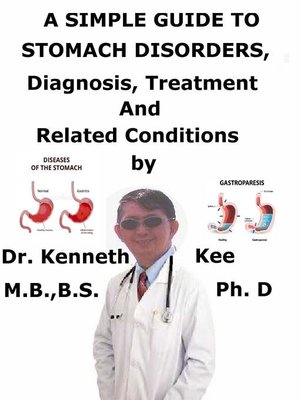A Simple Guide to Stomach Disorders, Diagnosis, Treatment and Related Conditions
ebook
By Kenneth Kee

Sign up to save your library
With an OverDrive account, you can save your favorite libraries for at-a-glance information about availability. Find out more about OverDrive accounts.
Find this title in Libby, the library reading app by OverDrive.



Search for a digital library with this title
Title found at these libraries:
| Library Name | Distance |
|---|---|
| Loading... |
This book describes Stomach Disorders, Diagnosis and Treatment and Related Diseases
"An army marches on its stomach."
Napoleon Bonaparte
"A way to a man's heart is through his stomach"
"When a man's stomach is full it makes no difference whether he is rich or poor"
Euripides
The stomach is an essential organ of digestion located between the esophagus (food pipe or gullet) and the duodenum (first part of the small intestine).
Like any other organ of the body, different diseases can involve the stomach.
This may cause disturbances in its action and symptoms such as:
1. Nausea,
2. Vomiting,
3. Pain,
4. Excessive belching and
5. Changes in appetite.
Stomach disorders are disorders that involve the stomach, either on its own or in conjunction with other parts of the digestive tract and organs.
Some stomach disorders are frequent, affecting the majority of the population at some point in their life.
Other stomach disorders are less frequent or rare.
Dependent on the form of stomach disorder, it can even lead to death if not treated properly and quickly.
The signs and symptoms of the different forms of stomach disorders are mostly similar since the same organ is affected.
Some of these disorders are inflammatory in nature or happen with damage to the stomach wall while others are due to abnormal growths, narrowing of certain parts of the stomach.
Because of the different mechanisms of the range of stomach disorders, the selection of treatment may differ.
There is a wide variety of stomach disorders that manifest with different signs and symptoms.
Some of these disorders may be exclusive to the stomach or involve adjacent parts of the gut, like the esophagus proximally (before the stomach) and small intestine distally (after the stomach).
Occasionally, the complete gastrointestinal tract may be involved producing different signs and symptoms and this is sometimes misdiagnosed as a disorder only within the stomach.
The most frequent stomach problems are inflammation of the stomach (gastritis) and ulcers (gastric ulcer).
Other frequent disorders like gastro-esophageal reflux disease affect the esophagus due to a weak lower esophageal sphincter (LES).
This fails to prevent the back flow of stomach acid into the esophagus and is normally associated with stomach disorders.
GERD is often not an effect of any stomach disorder, either structural or functional.
There is a wide variety of causes of the different stomach disorders.
These causes may differ between the different disorders.
Many of the same causes may be accountable for more than one stomach disorder.
Chronic H.pylori infection and the overuse of acid-suppressing drugs are indicated in many different forms of stomach disorders, from gastritis to stomach cancer.
Types of Stomach Disorders
Some of the more frequent stomach disorders with simple explanations of the disorder are:
1. Gastritis – Inflammation of the stomach wall
2. Stomach ulcers – Open sores in the stomach wall.
3. Hiatal hernia – Squeezing of stomach into the chest cavity.
4. Gastric outlet obstruction – blockage of the end portion of the stomach.
5. Delayed gastric emptying – slow exit of stomach contents.
6. Gastroparesis - Weakening or paralysis of stomach muscles
7. Stomach perforation - Tear or hole in stomach wall
8. Achlorhydria – too little or reduced acidity of the stomach acid.
9. Stomach cancer – Malignant growth in the stomach.
10. Stomach polyps – Protruding...







